Europe Data Center Cooling Market Size
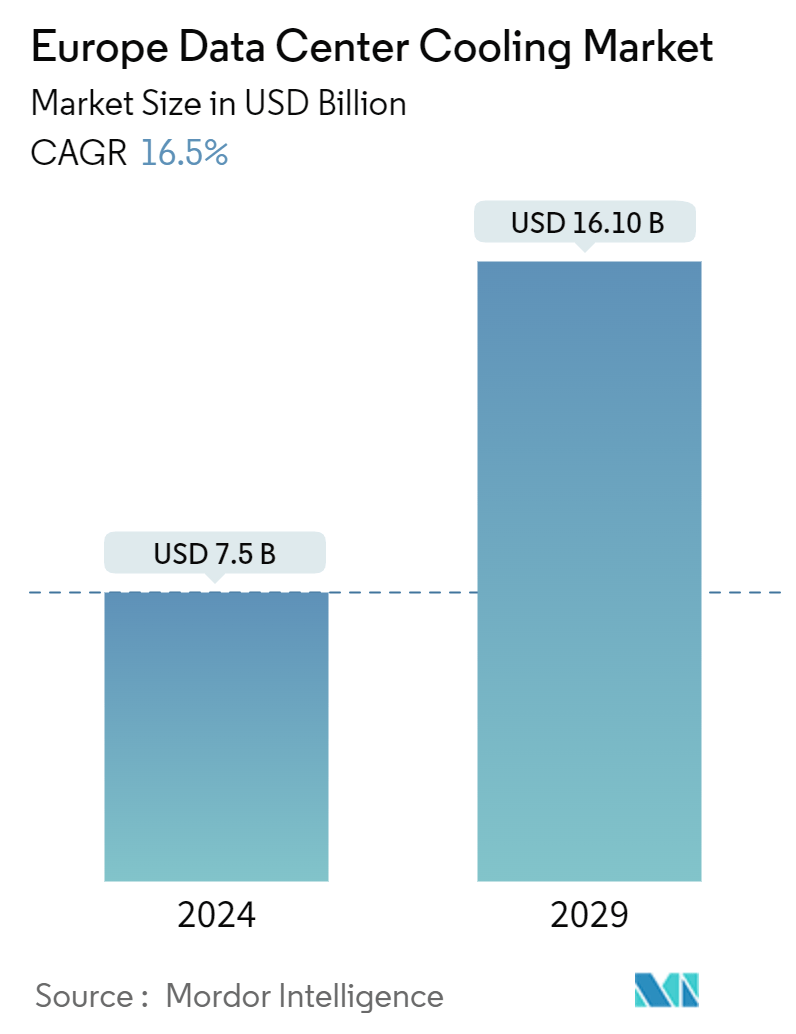
| Study Period | 2019 - 2029 |
| Base Year For Estimation | 2023 |
| Market Size (2024) | USD 7.5 Billion |
| Market Size (2029) | USD 16.10 Billion |
| CAGR (2024 - 2029) | 16.50 % |
| Market Concentration | Low |
Major Players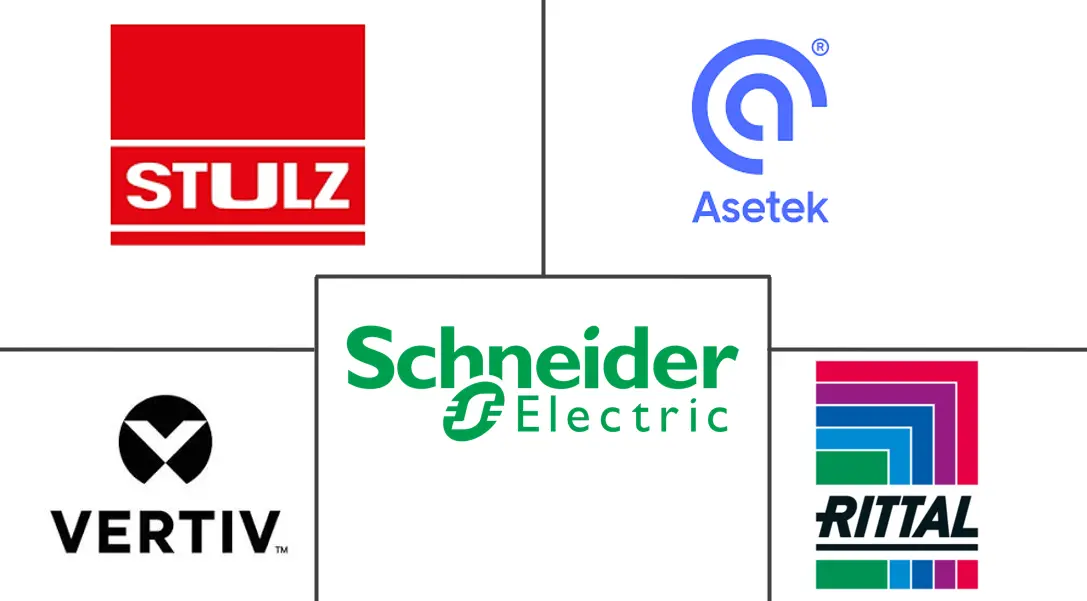
*Disclaimer: Major Players sorted in no particular order |
Europe Data Center Cooling Market Analysis
The Europe Data Center Cooling Market size is estimated at USD 7.5 billion in 2024, and is expected to reach USD 16.10 billion by 2029, growing at a CAGR of 16.5% during the forecast period (2024-2029).
The growing adoption of cloud computing among SMEs, government regulations for local data security, and growing investment by domestic players are some of the major factors driving the demand for data center cooling in the region.
- Cooling technologies are usually selected based on the data centers' geographical location. As companies regularly seek to mitigate costs, energy-efficient cooling methods are being considered the potential alternatives to traditional cooling methods. The market's growth is also fueled by edge computing adoption and the increase in IoT devices.
- Developments in IT Infrastructure in emerging European countries such as Hungary, Greece, Poland, and Turkey are expected to increase the construction of hyperscale data center facilities with over 50 MW power capacity. The United Kingdom, Germany, and France had the highest number of data centers across Europe, and market players can target these countries to invest in their new technologies. Also, they can form partnerships with upcoming data center organizations to cater to market requirements at a competitive price, aiding the growth of the European data center cooling market over the forecast period.
- The cooling systems are responsible for almost 40% of the data center power consumption. Companies are trying to tackle this issue by setting up green data centers. The growing trends toward deploying green data centers for storing, managing, and distributing information have helped many software companies reduce energy consumption and total energy costs. For example, green technologies, such as Immersion4 in combination with AI, are changing how data centers operate to make them more sustainable with efficient energy usage and low carbon footprint. Such green data centers' emergence drives the demand for cooling units in the region.
- Data center cooling systems require a high initial investment to set up, which could restrain the market. However, many local vendors and market players are developing innovative solutions by modifying the existing data centers at a low cost to reduce the cost of setting up a new unit. Additionally, reduced carbon emission and cooling issues during power outages could hamper the growth of the market.
- The COVID-19 pandemic impacted the market owing to lockdowns, shortage of devices, and supply chain disruptions to set up new data centers and update the existing data centers. On the other hand, there is a massive rise in data volume and mobile data usage in European countries, which is anticipated to boost the setup of data centers across Europe. This will propel the market growth over the forecast period. Also, government support is projected to boost the development of the data center cooling market over the forecast period.
Europe Data Center Cooling Market Trends
The Retail Segment is Expected to Hold a Significant Market Share
- In the retail segment, the increasing number of users in e-commerce and online spending is creating an enormous volume of Big Data, which is expected to propel the need for data storage, security, and reduced latency. This boosts the region's expenditure and the number of data centers. Rapid development in the retail sector and Industry 4.0 trends are also responsible for the rise of data centers, enhancing the need for cooling devices.
- Due to the increasing number of online users, foreign retail companies regularly invest in European countries to expand their storage capacity, increasing internet traffic and the load on data centers. For instance, JD.com, a Chinese e-commerce giant, recently confirmed a strategic entry into the European retail sphere. Due to stringent regulations in the region, foreign companies investing in the area may store their data locally for smooth transitions regarding the data protection law. As a result, the usage of data center cooling systems is expected to increase, thereby boosting the market growth in the region over the forecast period.
- Notably, according to the E-commerce Foundation, the European B2C e-commerce turnover is expected to expand by approximately 13% to reach USD 621 billion due to the high internet penetration in the region. It may increase the Big Data volume, leading to more data centers and cooling systems in the area.
- According to Eurostat, Italy and Poland witnessed tremendous growth in e-commerce users. It led to the generation of a vast amount of data, thereby strengthening storage requirements. As a result, the European data center cooling market is expected to grow over the forecast period.
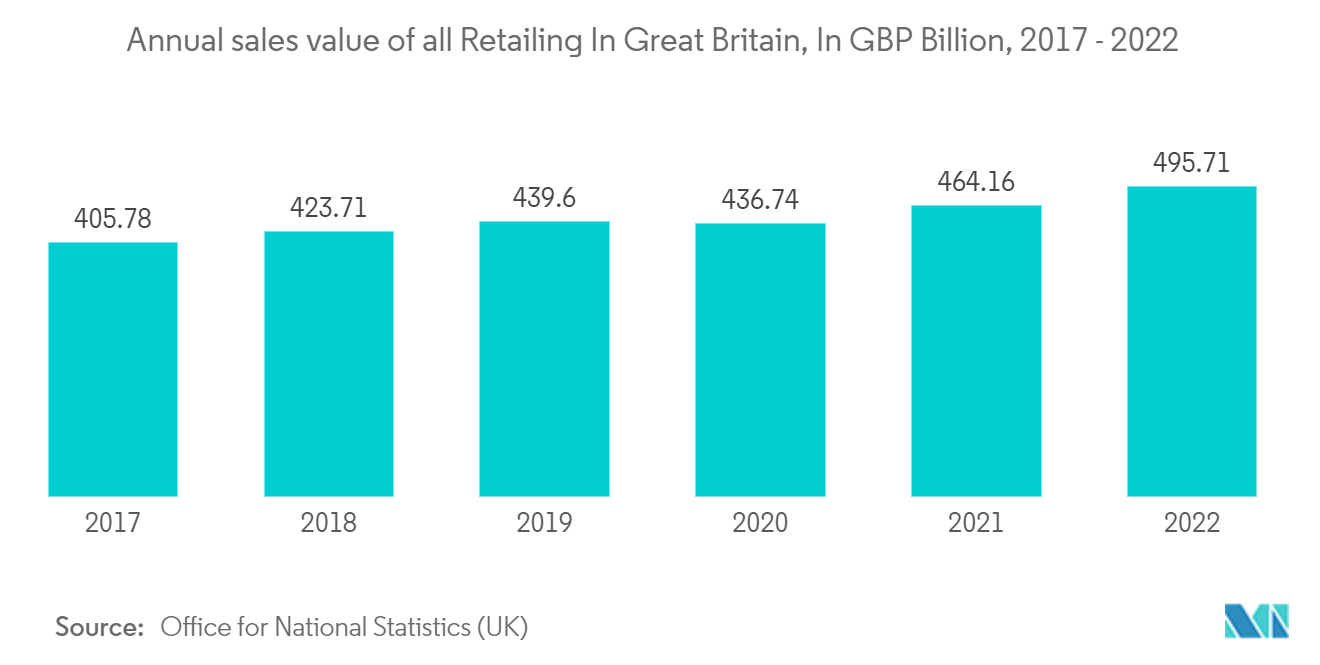
The United Kingdom Accounts For the Largest Market Share
- Companies in the UK are rigorously investing in new data centers, and this is expected to positively impact the market growth in the region over the forecast period. For instance, Interxion, a European colocation and networking company, commenced its third data center in London, expanding carriers and CDNs for consumers. This development is expected to propel cooling system utilization and foster market growth.
- H&M, a fashion retailer in the country, plans to integrate a cooling and heat recovery system in its new data center in Stockholm. The excess heat generated from the data center is reused by Fortum Värme, an energy company, by distributing it to customers (2,500 modern residential apartments at full load) throughout the city.
- The UK recorded the highest number of data centers across Europe. Market players can target these countries to invest in their new technologies. Also, they can form partnerships with upcoming data center organizations to cater to their requirements at a competitive price, which may aid the growth of the European data center cooling market over the forecast period.
- Green and renewable solutions, such as green electricity, water reclamation, zero water cooling systems, recycling, and waste management, are being used to build the most sustainable data centers. Growth in Big Data volume across European countries, including the United Kingdom, is expected to increase the need for low-latency and high-capacity data centers, thereby boosting cooling system utilization. According to Science Direct, data center energy use might account for 2.13% of worldwide electricity supply over the forecast period.
- Companies are regularly trying to reduce their operational cost across their verticals, increasing the AI technology used in data center cooling systems in the country. For instance, Siemens introduced AI-based thermal optimization, wherein the company utilizes Vigilant AI products to enhance cooling systems in data centers.
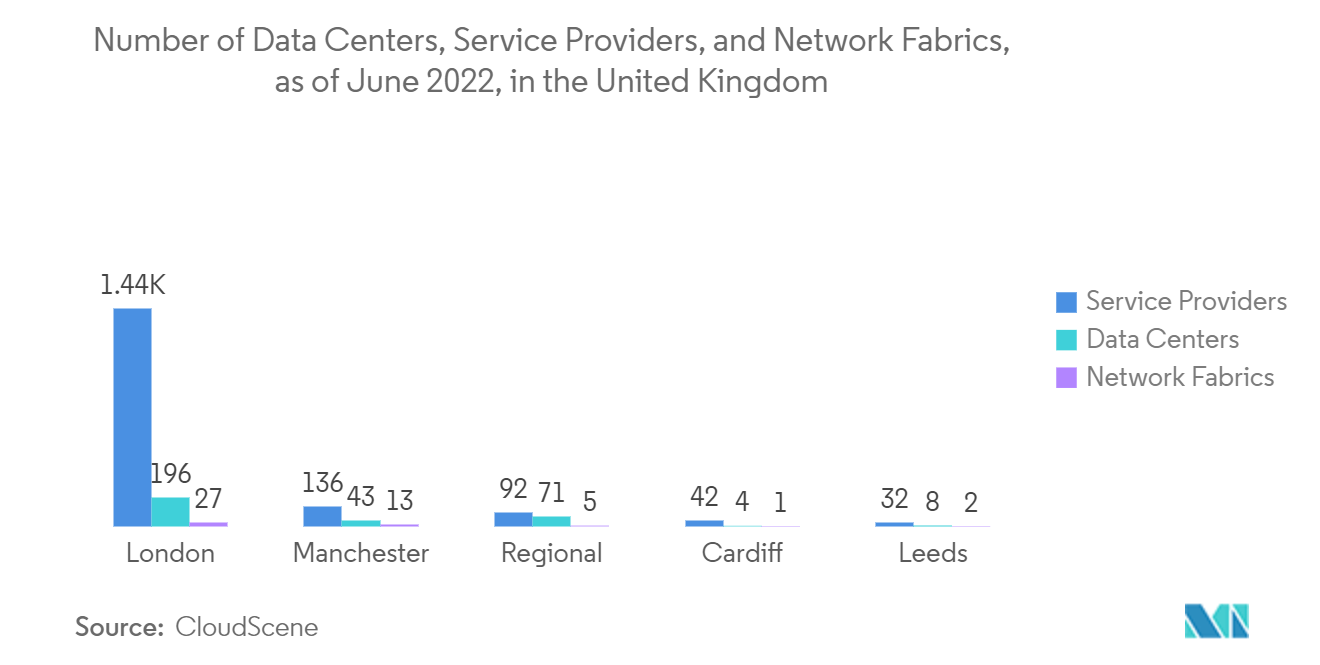
Europe Data Center Cooling Industry Overview
The European data center cooling market is fragmented as the benefits offered by the technology and support from the government by imposing efficiency regulations on data centers are expected to help the growth of the data center cooling market. Some major market players are IBM Corporation, Fujitsu Ltd, Hitachi Ltd, Hewlett-Packard Enterprise, and Schneider Electric SE. Market penetration is growing with a strong presence of major players in established markets. With the increasing focus on innovation, the demand for new technologies is growing, which, in turn, is driving investments for further developments.
- May 2024: Rittal, in collaboration with multiple hyperscale data center operators, developed a modular cooling system. This solution boasts a cooling capacity exceeding 1 MW, achieved through direct water cooling. It is specifically tailored to cater to the high-power densities of AI applications.
- January 2024: Aligned Data Centers, the technology infrastructure company providing sustainable, innovative, and adaptive scale data centers and build-to-scale solutions for global hyperscale and enterprise customers, introduced its DeltaFlow liquid cooling technology, a patent-pending solution built to support the high-density compute requirements of next-generation applications and high-performance computing, including artificial intelligence, machine learning, and supercomputers. DeltaFlow extended Aligned's ExpandOnDemand capabilities, providing customers the flexibility to seamlessly scale and pivot to support shifting computing environments.
Europe Data Center Cooling Market Leaders
-
Vertiv Group Corp.
-
Stulz GmbH
-
Schneider Electric SE
-
Rittal GmbH & Co. KG
-
Asetek A/S
*Disclaimer: Major Players sorted in no particular order
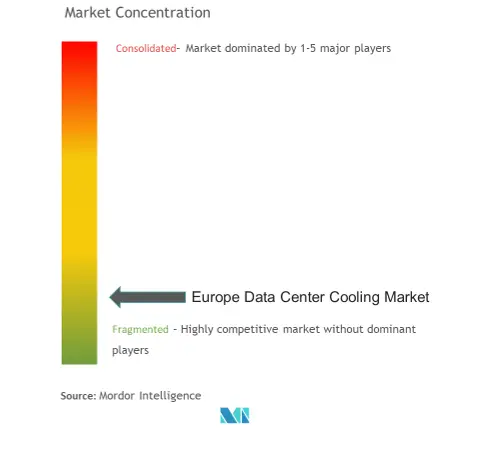
Europe Data Center Cooling Market News
- May 2024: Stulz unveiled its latest innovation, the CyberCool Coolant Management and Distribution Unit (CDU), specifically engineered to optimize heat exchange efficiency in liquid cooling solutions. The product line comprises four models, available in two distinct sizes. These units boast an impressive heat exchange capacity, ranging from 345 kW to 1,380 kW. Stulz set the rated water supply temperature for the facility water system at 32°C (89.6°F), with the liquid supply temperature for the technology cooling system marked at 36°C (96.8°F).
- October 2023: Mitsubishi Heavy Industries Ltd introduced a new 40 kVA-class 12 ft container-type data center with an immersion/air-cooled hybrid cooling system capable of simultaneously housing servers utilizing three types of cooling methods: air cooling (8 kVA), immersion cooling (25 kVA), and water cooling (8 kVA).
Europe Data Center Cooling Market Report - Table of Contents
1. INTRODUCTION
- 1.1 Study Assumptions and Market Definition
- 1.2 Scope of the Study
2. RESEARCH METHODOLOGY
3. EXECUTIVE SUMMARY
4. MARKET INSIGHTS
- 4.1 Market Overview (Coverage: A detailed analysis of the current regional trends related to Data Center Cooling are included in this section)
-
4.2 Key cost considerations for Cooling
- 4.2.1 Analysis of the key cost overheads related to DC operations with an eye on DC Cooling
- 4.2.2 Key innovations and developments in Data Center Cooling
- 4.2.3 Key energy efficiency practices adopted in Data Centers
5. MARKET DYNAMICS
- 5.1 Market Drivers (Key factors such as the increased emphasis on energy consumption, move towards green solutions are mapped based on their relative impact over the next 5-7 years)
- 5.2 Market Challenges (Key factors such as the dynamic nature of regulations, evolving customer needs are mapped based on their relative impact over the next 5-7 years)
- 5.3 Market Opportunities
- 5.4 Comparison of raised floor with containment & raised floor without commitment
- 5.5 Industry Ecosystem Analysis
6. ANALYSIS OF THE CURRENT REGIONAL DATA CENTER FOOTPRINT
- 6.1 Regional Analysis of IT Load Capacity & Area Footprint of Data Centers (for the period of 2017-2030)
- 6.2 Regional Analysis of the Established DC Markets and Emerging DC Hotspots in Europe region (we will include coverage by highlighting major established and emerging DC markets)
- 6.3 Regional Analysis of Regulatory Framework On DC Cooling
7. DATA CENTER COOLING MARKET SEGMENTATION
-
7.1 By Cooling Technology (Key trends, market size estimates & projections for the period of 2022-2029 and future outlook)
- 7.1.1 Air-based Cooling
- 7.1.1.1 CRAH
- 7.1.1.2 Chiller and Economizer
- 7.1.1.3 Cooling Tower (covers direct, indirect & two-stage cooling)
- 7.1.1.4 Others
- 7.1.2 Liquid-based Cooling
- 7.1.2.1 Immersion Cooling
- 7.1.2.2 Direct-to-Chip Cooling
- 7.1.2.3 Rear-Door Heat Exchanger
-
7.2 By End-user Vertical
- 7.2.1 IT & Telecom
- 7.2.2 Retail & Consumer Goods
- 7.2.3 Healthcare
- 7.2.4 Media & Entertainment
- 7.2.5 Federal & Institutional agencies
- 7.2.6 Other End Users
-
7.3 By Country***
- 7.3.1 United Kingdom
- 7.3.2 Germany
- 7.3.3 Russia
- 7.3.4 Denmark
- 7.3.5 Norway
- 7.3.6 Netherlands
- 7.3.7 Spain
- 7.3.8 Poland
- 7.3.9 Switzerland
- 7.3.10 Austria
- 7.3.11 Belgium
- 7.3.12 France
- 7.3.13 Italy
- 7.3.14 Ireland
- 7.3.15 Sweden
8. COMPETITIVE LANDSCAPE
-
8.1 Company Profiles
- 8.1.1 Vertiv Group Corp.
- 8.1.2 Stulz GmbH
- 8.1.3 Schneider Electric SE
- 8.1.4 Rittal GmbH & Co. KG
- 8.1.5 Asetek A/S
- 8.1.6 Alfa Laval AB
- 8.1.7 Iceotope Technologies Limited
- 8.1.8 Green Revolution Cooling Inc.
- 8.1.9 Chilldyne Inc.
- 8.1.10 Airedale International Air Conditioning Ltd
- *List Not Exhaustive
9. INVESTMENT ANALYSIS
10. MARKET OPPORTUNITIES AND FUTURE TRENDS
** Subject To AvailablityEurope Data Center Cooling Industry Segmentation
Data center cooling refers to the collective equipment, tools, techniques, and processes that ensure an ideal operating temperature within a data center facility. With increasing capacity and higher density, there is an increasing need for IT equipment with energy-efficient cooling. The benefits offered by the technology and support from the government by imposing efficiency regulations on data centers are expected to boost the growth of the market directly in various fields, such as IT, BFSI, telecommunication, etc., in the region.
The European data center cooling market is segmented by cooling technology (air-based cooling (CRAH, chiller and economizer, cooling tower (direct, indirect, and two-stage cooling), and others)) and liquid-based cooling (immersion cooling, direct-to-chip cooling, and rear-door heat exchanger)), end-user vertical (IT & telecom, retail & consumer goods, healthcare, media & entertainment, federal & institutional agencies, and other end users), and geography (the United Kingdom, Germany, Russia, Denmark, Norway, the Netherlands, Spain, Poland, Switzerland, Austria, Belgium, France, Italy, Ireland, Sweden, and the Rest of Europe). The market sizes and forecasts are provided in terms of value (USD) for all the above segments.
| By Cooling Technology (Key trends, market size estimates & projections for the period of 2022-2029 and future outlook) | Air-based Cooling | CRAH |
| Chiller and Economizer | ||
| Cooling Tower (covers direct, indirect & two-stage cooling) | ||
| Others | ||
| By Cooling Technology (Key trends, market size estimates & projections for the period of 2022-2029 and future outlook) | Liquid-based Cooling | Immersion Cooling |
| Direct-to-Chip Cooling | ||
| Rear-Door Heat Exchanger | ||
| By End-user Vertical | IT & Telecom | |
| Retail & Consumer Goods | ||
| Healthcare | ||
| Media & Entertainment | ||
| Federal & Institutional agencies | ||
| Other End Users | ||
| By Country*** | United Kingdom | |
| Germany | ||
| Russia | ||
| Denmark | ||
| Norway | ||
| Netherlands | ||
| Spain | ||
| Poland | ||
| Switzerland | ||
| Austria | ||
| Belgium | ||
| France | ||
| Italy | ||
| Ireland | ||
| Sweden |
Europe Data Center Cooling Market Research FAQs
How big is the Europe Data Center Cooling Market?
The Europe Data Center Cooling Market size is expected to reach USD 7.5 billion in 2024 and grow at a CAGR of 16.5% to reach USD 16.10 billion by 2029.
What is the current Europe Data Center Cooling Market size?
In 2024, the Europe Data Center Cooling Market size is expected to reach USD 7.5 billion.
Who are the key players in Europe Data Center Cooling Market?
Vertiv Group Corp., Stulz GmbH, Schneider Electric SE, Rittal GmbH & Co. KG and Asetek A/S are the major companies operating in the Europe Data Center Cooling Market.
What years does this Europe Data Center Cooling Market cover, and what was the market size in 2023?
In 2023, the Europe Data Center Cooling Market size was estimated at USD 6.26 billion. The report covers the Europe Data Center Cooling Market historical market size for years: 2019, 2020, 2021, 2022 and 2023. The report also forecasts the Europe Data Center Cooling Market size for years: 2024, 2025, 2026, 2027, 2028 and 2029.
Europe Data Center Cooling Industry Report
Statistics for the 2024 Europe Data Center Cooling market share, size and revenue growth rate, created by Mordor Intelligence™ Industry Reports. Europe Data Center Cooling analysis includes a market forecast outlook to 2029 and historical overview. Get a sample of this industry analysis as a free report PDF download.



